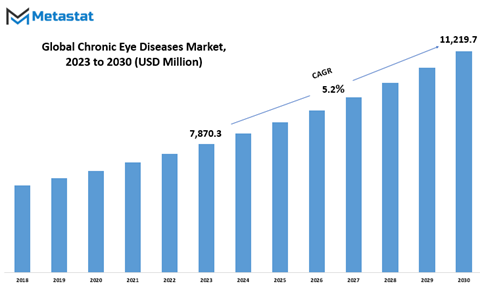MARKET OVERVIEW
The Chronic Eye Diseases Market is a dynamic and multifaceted ecosystem, consisting of various stakeholders, each contributing their expertise and resources towards the common goal of enhancing eye health. This domain plays addresses the medical needs of millions of individuals worldwide who are grappling with conditions such as glaucoma, age-related macular degeneration (AMD), diabetic retinopathy, and other ocular disorders that can significantly impact one's quality of life. This essay delves into the Chronic Eye Diseases Market, offering insights into its composition, the challenges it faces, the evolving landscape, and the pivotal role it plays in ensuring the well-being of patients with chronic eye diseases.
Pharmaceutical companies are at the forefront, constantly innovating to develop new drugs and therapies to treat chronic eye diseases. These companies invest heavily in research and development to discover novel treatments and improve existing ones. Medications, such as anti-VEGF drugs for AMD or prostaglandin analogs for glaucoma, are prime examples of their contributions.
Medical device manufacturers also form an integral part of the market, producing cutting-edge tools and devices used in diagnostics, surgical procedures, and patient management. These innovations have revolutionized the way chronic eye diseases are diagnosed and treated, from advanced imaging techniques to minimally invasive surgical instruments.
Healthcare professionals, including ophthalmologists, optometrists, and retina specialists, are the linchpin of this market, as they provide clinical expertise and deliver personalized care to patients. Their role extends from early diagnosis to the long-term management of chronic eye diseases, ensuring that patients receive the best possible care.
Global Chronic Eye Diseases market is estimated to reach $11,219.7 Million by 2030; growing at a CAGR of 5.2% from 2023 to 2030.

GROWTH FACTORS
It is essential to understand the key driving forces, potential challenges, and opportunities that shape this market's trajectory. Chronic eye diseases, such as glaucoma, diabetic retinopathy, and age-related macular degeneration, affect a significant portion of the global population. The prevalence of these diseases, often linked to aging and lifestyle factors, has led to a growing demand for effective treatments and management solutions. This rising incidence of chronic eye diseases is a key driving factor behind the growth of the market.
Another crucial driver is the continuous advancements in medical technology and treatments. Innovations in diagnostic tools, surgical techniques, and pharmaceuticals have improved the management of chronic eye diseases. These innovations not only enhance patient outcomes but also attract investment and interest from healthcare providers and pharmaceutical companies.
However, challenges persist. The high cost of treatments and medications for chronic eye diseases can be a barrier to access, particularly in regions with limited healthcare resources. Additionally, the lack of awareness and early detection in some areas hampers timely intervention and treatment.
Market growth is also influenced by regulatory and reimbursement issues. Stringent regulatory requirements can slow down the approval process for new treatments, while uncertainties in reimbursement policies can affect the affordability of chronic eye disease management.
Despite these challenges, opportunities lie ahead. The growing elderly population, particularly in developed countries, creates a substantial market for chronic eye disease management. Additionally, the increasing focus on telemedicine and remote patient monitoring can improve access to care and early detection, thereby driving market growth.
The Chronic Eye Diseases Market is shaped by a complex interplay of factors. The increasing prevalence of chronic eye diseases and ongoing advancements in medical technology are key drivers. However, cost barriers, limited awareness, and regulatory issues can hinder growth. Looking forward, opportunities in the aging population and telemedicine hold promise for the market's expansion in the coming years.
MARKET SEGMENTATION
By Type
The market for chronic eye diseases is a dynamic landscape with various segments contributing to its growth. These segments shed light on the diversity and complexity of the challenges posed by chronic eye diseases, including the economic burden, treatment approaches, and the importance of raising awareness.
One of the key segments in the chronic eye diseases market is categorized by type. Within this category, we find several subsegments that are instrumental in understanding the nuances of these diseases. In this context, the Diabetic and Hypertensive Retinopathy segment plays a crucial role. In the year 2020, this segment was valued at a substantial 1517.9 USD Million. This figure reflects the significance of these retinopathies in the landscape of chronic eye diseases.
Another notable subsegment is Age-Related Macular Degeneration (AMD). In the same year, the Age-Related Macular Degeneration segment had a valuation of 1615.4 USD Million. This segment's prominence underscores the prevalence and impact of AMD, a condition primarily affecting older individuals.
Cataracts, a well-known eye condition, also hold a substantial market value. In 2020, the Cataracts segment was valued at 1274.7 USD Million. The prevalence of cataracts and the demand for effective treatment options contribute to this value.
Thyroid Ophthalmopathy, often associated with Grave's Disease, is another vital subsegment. In 2020, the Thyroid Ophthalmopathy segment had a valuation of 736.2 USD Million. This segment highlights the importance of addressing eye conditions linked to thyroid disorders.
Glaucoma Dry Eye, a condition involving multiple complexities, represents a significant portion of the market. In 2020, the Glaucoma Dry Eye segment was valued at 1173.3 USD Million. This value reflects the need for comprehensive approaches to manage glaucoma and associated dry eye symptoms.
The market also includes others segment, encompassing a range of less prevalent chronic eye diseases. This segment was valued at 480.6 USD Million in 2020. While individually these conditions may have lower prevalence, collectively, they contribute to the diversity of challenges within the chronic eye diseases market.
The chronic eye diseases market is a multifaceted domain with various subsegments. Each subsegment represents a unique set of challenges, treatment needs, and economic considerations. The values associated with these segments in 2020 provide insights into the economic and healthcare landscape of chronic eye diseases, highlighting the importance of continued research, innovation, and patient-focused approaches to tackle these conditions effectively.

By Product Type
The Chronic Eye Diseases market is a diverse landscape, with various product types catering to the specific needs of patients. These products play a crucial role in managing and treating chronic eye conditions. Among the product types, we find Eye Drops, Eye Ointment, Gel, Liquid Wipes, and Others.
Eye Drops, a widely used product in this market, had a substantial value of 3952.2 USD Million in 2020. Eye Drops are a common choice for patients due to their ease of application and quick relief from symptoms. They are available in various formulations, from artificial tears to medicated drops, offering a wide range of options to address different eye conditions.
Eye Ointment, another significant product segment, was valued at 1390.9 USD Million in 2020. Eye ointments provide a longer-lasting effect compared to eye drops. They are especially beneficial for individuals with chronic conditions that require sustained lubrication and protection. Ointments are often used before bedtime to provide overnight relief.
Gel, often used in conjunction with eye drops and ointments, is an essential part of the Chronic Eye Diseases market. The Gel segment held a value of 1028.2 USD Million in 2020. Eye gels are known for their ability to provide prolonged hydration and are particularly useful for individuals with severe dry eye conditions. They offer a thicker, more viscous consistency compared to drops or ointments, ensuring prolonged contact with the eye surface.
Liquid Wipes, valued at 1028.2 USD Million in 2020, are a convenient choice for individuals seeking quick and easy eye hygiene. These wipes are often used for cleaning and refreshing the eye area. They provide a hassle-free solution for maintaining eye health, especially when on the go.
The Others segment, valued at 426.8 USD Million in 2020, encompasses a variety of products that cater to specific needs within the Chronic Eye Diseases market. This category includes innovative solutions and emerging products that offer unique benefits to patients. These products are continually evolving to provide more effective and convenient options for managing chronic eye conditions.
The Chronic Eye Diseases market offers a range of product types, each designed to address specific needs in the management and treatment of chronic eye conditions. From the widely used Eye Drops to the long-lasting relief provided by Eye Ointments and Gels, and the convenience of Liquid Wipes, patients have access to diverse options. The Others category also ensures that the market continues to innovate and evolve, promising a brighter future for individuals with chronic eye diseases.
By Medication
The Chronic Eye Diseases market involves various medication segments that play a crucial role in addressing eye-related health issues. These segments are Anti-Inflammatory, Immunosuppressive, Anti-Glaucoma, Lubricating Agents, and Others.
The Anti-Inflammatory segment within this market held a substantial value of 2895.8 USD Million in the year 2020. This segment primarily deals with medications aimed at reducing inflammation in the eye. Inflammation can be a common issue in various chronic eye conditions, and anti-inflammatory medications are designed to alleviate these symptoms, providing relief to patients.
Another significant segment is the Immunosuppressive segment, which was valued at 1129.7 USD Million in 2020. This category of medications is vital in cases where the immune system needs to be suppressed to prevent it from attacking the eye's own tissues. This is particularly relevant in autoimmune eye diseases where the body's immune response is misdirected.
The Anti-Glaucoma segment, with a value of 1095.7 USD Million in 2020, focuses on addressing one of the most common eye conditions, glaucoma. These medications help in reducing intraocular pressure, a key factor in managing and preventing the progression of glaucoma.
Lubricating Agents, valued at 933.2 USD Million in 2020, serve a different purpose. They are essential in providing relief to individuals with chronic dry eye conditions. Lubricating agents help in maintaining the moisture and lubrication on the eye's surface, reducing discomfort and irritation.
The Others segment, with a value of 743.7 USD Million in 2020, encompasses medications that may not fit directly into the categories mentioned above. This segment could include a range of specialized medications catering to various chronic eye conditions not covered by the primary segments.
Each of these medication segments within the Chronic Eye Diseases market plays a vital role in managing and treating a range of eye-related health issues. They contribute to improving the quality of life for individuals suffering from chronic eye diseases by addressing specific symptoms and underlying causes, ultimately enhancing their eye health and overall well-being.
By Route of Administration
The global market for chronic eye diseases encompasses several routes of administration, each contributing to the overall landscape. These diverse avenues reflect the evolving strategies in treating chronic eye conditions. Four key segments, namely Oral, Topical, Ocular, and Others, play pivotal roles in addressing the challenges posed by chronic eye diseases.
Oral administration, valued at 311.2 USD million in 2020, represents one of the approaches in managing chronic eye conditions. This route involves the use of oral medications, which may provide systemic relief from eye-related issues. Such treatments are designed to target not just the symptoms but also the underlying causes of chronic eye diseases.
Topical administration, with a market valuation of 2390.7 USD million in 2020, offers an external approach. Topical treatments typically come in the form of eye drops or ointments. These products are applied directly to the eye's surface, providing targeted relief for conditions like dry eye or glaucoma. They are convenient and directly address the affected area.
Ocular administration, valued at 3952.2 USD million in 2020, takes a more specialized route. Ocular treatments are designed for intraocular delivery, meaning they are administered within the eye. This approach is often used for severe and chronic conditions, such as age-related macular degeneration, where direct treatment is necessary for better outcomes.
The Others segment, which accounted for 144 USD million in 2020, encompasses alternative routes of administration. This category includes innovative methods and emerging technologies that are continually expanding the options for treating chronic eye diseases. It represents a dynamic and evolving sector in the field.
The choice of administration route is influenced by various factors, including the nature and severity of the chronic eye condition, patient preferences, and the efficacy of available treatments. The chronic eye diseases market, with its diverse routes of administration, underscores the ongoing efforts to enhance the quality of life for individuals affected by these conditions. In a rapidly advancing medical landscape, these options provide hope for improved management and, ultimately, better outcomes for those living with chronic eye diseases.
REGIONAL ANALYSIS
The global market for Chronic Eye Diseases is segmented based on geography, specifically into North America and Europe. This division allows for a more focused analysis of the market's dynamics in these regions.
North America, comprising the United States and Canada, is a significant player in the global Chronic Eye Diseases market. The region boasts a robust healthcare infrastructure, advanced medical technologies, and a high prevalence of eye-related disorders. These factors contribute to the market's growth and innovation. Additionally, the presence of key pharmaceutical and biotechnology companies in North America further propels research and development efforts for chronic eye disease treatments.
Europe, encompassing countries like the United Kingdom, Germany, and France, also holds a substantial share in the global market. The European market benefits from a well-established healthcare system and a growing elderly population prone to chronic eye diseases. This demographic shift necessitates increased medical attention to address age-related eye conditions, fueling the demand for treatments and therapies.
Moreover, Europe has a strong focus on research and development, fostering collaborations between academic institutions, pharmaceutical companies, and healthcare providers. This collaborative environment promotes the discovery of novel treatments and therapies for chronic eye diseases.
In summary, the geographical segmentation of the global Chronic Eye Diseases market into North America and Europe allows for a targeted analysis of market trends, treatment innovations, and research efforts in these regions. Both North America and Europe play pivotal roles in advancing the treatment landscape for chronic eye diseases, catering to the needs of their respective populations.
COMPETITIVE PLAYERS
The Chronic Eye Diseases industry is a dynamic sector with various influential players. Among these key figures, we find Novartis AG and AbbVie.
Novartis AG, a prominent name in the pharmaceutical world, has a significant presence in the Chronic Eye Diseases arena. The company is known for its dedication to developing innovative treatments and therapies for a range of eye conditions. Novartis has established itself as a leader in this field, contributing to advancements in the management and treatment of chronic eye diseases. Their commitment to research and development has resulted in the introduction of cutting-edge medications that have improved the lives of countless individuals grappling with these conditions.
AbbVie, another major player in the Chronic Eye Diseases industry, has made substantial contributions to the field. The company's focus on research and innovation has led to the development of groundbreaking therapies for chronic eye diseases. AbbVie's efforts in creating effective treatments have not only provided new options for patients but have also raised the overall standard of care in the industry. Their dedication to improving the lives of those affected by chronic eye diseases is evident in their ongoing research initiatives and the continuous development of advanced therapies.
Both Novartis AG and AbbVie play pivotal roles in advancing the treatment landscape for chronic eye diseases. Their contributions, marked by a commitment to innovation and patient well-being, have a lasting impact on the industry. These key players exemplify the industry's drive to provide better solutions and a brighter future for individuals affected by chronic eye diseases.
Chronic Eye Diseases Market Key Segments:
By Type
- Diabetic and Hypertensive Retinopathy
- Age-Related Macular Degeneration (Amd)
- Cataracts
- Thyroid Ophthalmopathy (Grave’s Disease)
- Glaucoma Dry Eye
- Others
By Product Type
- Eye Drops
- Eye Ointment
- Gel
- Liquid Wipes
- Others
By Medication
- Anti-Inflammatory
- Immunosuppressive
- Anti-Glaucoma
- Lubricating Agents
- Others
By Route of Administration
- Oral
- Parenteral
- Ocular
- Others
Key Global Chronic Eye Diseases Industry Players
- Novartis AG
- AbbVie
- Alcon
- Akorn
- Santen Pharmaceutical Co., Ltd.
- Bausch & Lomb Incorporated
- Kala Pharmaceuticals
- Ocular Therapeutics
- Regeneron Pharmaceuticals
- OASIS Medical
- Sun Ophthalmics
- OCULUS Surgical
- VISUfarma
- Sentiss Pharma
- Aerie Pharmaceuticals
WHAT REPORT PROVIDES
- Full in-depth analysis of the parent Industry
- Important changes in market and its dynamics
- Segmentation details of the market
- Former, on-going, and projected market analysis in terms of volume and value
- Assessment of niche industry developments
- Market share analysis
- Key strategies of major players
- Emerging segments and regional growth potential








 US: +1 3023308252
US: +1 3023308252






